Texas’housing market boom continues
Texas housing market continues to impress, with home sales and prices rising strongly. This is not surprising, given that the state’s economy expanded by a robust 4.7% in Q2 2019– the highest growth among the 50 U.S. states.

The Texas housing market is expected to remain vibrant, because of attractive combination of strong growth, high rental yields ranging from 6.4% to 13.3%, yet lower house prices than other states - so investors can earn well. However the rental vacancy rate is high, i.e., investors need to take care where they buy.
The Federal Housing Finance Agency’s seasonally-adjusted purchase-only Texas house price index rose by 4.88% during the year to Q3 2019 (3.07% inflation-adjusted), down from 5.94% the same time last year.
The median home price increased 4.3% to US$245,000 in Q3 2019 from a year earlier, according to Texas Realtors. In Dallas-Forth Worth-Arlington area (30% of the Texas market) the median price rose by 3.6% y-o-y to US$275,501 in Q3 2019. The median price increased 4.7% to US$247,000 in Houston-The Woodlands-Sugar Land, 4% to US$235,000 in San Antonio-New Braunfels, and 3.9% to US$319,900 in Austin-Round Rock area.
Sales continue to rise thanks to strong US demand, despite less purchases by foreigners. Sales rose by 6.4% in Q3 2019 from a year earlier, a sharp improvement from y-o-y rises of 1% in Q2 and 0.7% in Q1, according to Texas Realtors.
Residential construction is increasing. New privately-owned housing units authorized in Texas rose by 7.3% in the first ten months of 2019 to 168,006 units, following annual growth of 10.1% in 2018 and 5.6% in 2017, according to the US Census Bureau.
The Texas economy is the second largest in the U.S., next to California. Texas´ population is 28.7 million people – around 8.8% of the country’s total. In fact if Texas was a country, its economy would be the tenth largest in the world, at US$1.8 trillion. However its median household income of US$60,629 was slightly lower in 2018 than the national average of US$61,937.
Foreign homebuyers
Texas ranks third among US states, behind only Florida and Canada, for home sales to international buyers, and is particularly popular with buyers from Mexico and India.However foreign homebuyers´ purchases fell 28% from a year earlier in 2018 to the lowest level in six years, according to the Texas Realtors.
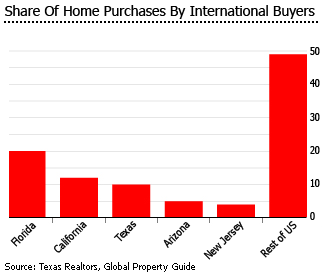
Despite declining foreign purchases, local investors are keeping the Texas market afloat:
- InDallas-Forth Worth-Arlington, closed sales rose by 5.7% y-o-y to 29,204 units in Q3 2019
- In Houston-The Woodlands-Sugar Land, closed sales rose by 7.7% to 25,661 units in Q3 2019 from a year earlier
- In Austin-Round Rock, closed sales increased 8.4% y-o-y to 10,207 units in Q3 2019
- In San Antonio-New Braunfels, sales were up by 7.3% y-o-y to 9,959 units in Q3 2019
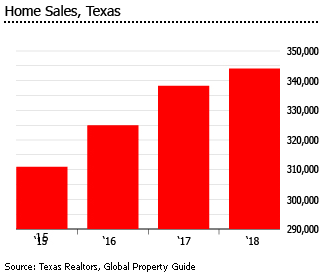
Residential properties typically stayed on the market for a total 87 days in Q3 2019, up from 85 days a year earlier.
High rental yields, rising rents
Gross rental yields are high in Texas, ranging from as high as 13.3% in Potter, Amarillo to 6.4% in Travis, Austin-Round Rock, according to ATTOM Data Solutions’ 2019 Single Family Rental Report.
In major areas:
- In Houston-The Woodlands-Sugar Land, gross rental yields range from 7.4% to 9.2%
- In Dallas-Fort Worth-Arlington, yields range from 6.5% to 10%
- In Austin-Round Rock-Georgetown, yields range from 6.4% to 9.2%
- In San Antonio-New Braunfels, yields averaged 9.1%
TEXAS GROSS RENTAL YIELDS, 2019 |
||
| County | Metro Area | Gross Yields |
| Potter | Amarillo | 13.30% |
| El Paso | El Paso | 11.00% |
| Nueces | Corpus Christi | 10.60% |
| Lubbock | Lubbock | 10.50% |
| Jefferson | Beaumont-Port Arthur | 10.50% |
| Kaufman | Dallas-Fort Worth-Arlington | 10.00% |
| Grayson | Sherman-Denison | 9.50% |
| Bell | Killeen-Temple | 9.40% |
| Hays | Austin-Round Rock | 9.20% |
| Harris | Houston-The Woodlands-Sugar Land | 9.20% |
| Ellis | Dallas-Fort Worth-Arlington | 9.20% |
| Comal | San Antonio-New Braunfels | 9.10% |
| Bexar | San Antonio-New Braunfels | 9.10% |
| Johnson | Dallas-Fort Worth-Arlington | 9.10% |
| Dallas | Dallas-Fort Worth-Arlington | 9.10% |
| Galveston | Houston-The Woodlands-Sugar Land | 8.90% |
| Gregg | Longview | 8.80% |
| Hidalgo | McAllen-Edinburg-Mission | 8.70% |
| Williamson | Austin-Round Rock | 8.40% |
| Tarrant | Dallas-Fort Worth-Arlington | 8.30% |
| Randall | Amarillo | 8.20% |
| Montgomery | Houston-The Woodlands-Sugar Land | 8.00% |
| Brazoria | Houston-The Woodlands-Sugar Land | 8.00% |
| Guadalupe | Austin-Round Rock | 7.90% |
| Fort Bend | Houston-The Woodlands-Sugar Land | 7.40% |
| Denton | Dallas-Fort Worth-Arlington | 7.40% |
| Brazos | College Station-Bryan | 7.30% |
| Collin | Dallas-Fort Worth-Arlington | 6.50% |
| Travis | Austin-Round Rock | 6.40% |
| Source: ATTOM Data Solutions | ||
In October 2019, the average rent for all residential properties in Texas rose by 1.7% y-o-y to US$1,561 per month, according to Zillow Rent Index. Over the same period, rents increased by 1.9% for single-family homes and by 1.3% for condos.

Midland Metro had the most expensive rental housing in Texas in October 2019, with an average rent of US$2,522 per month, according to Zillow. Rents were also high in Odessa (US$2,114), Austin-Round Rock (US$1,819), Dallas-Fort Worth-Arlington (US$1,745), Houston-The Woodlands-Sugar Land (US$1,667), San Antonio-New Braunfels (US$1,468), College Station-Bryan (US$1,464), and Levelland (US$1,451).
Texarkana and Marshall had the lowest monthly rents of US$917 and US$957, respectively.
Rental vacancy rate remains high
Despite these high yields, Texas’ rental vacancy rate stood at 9.6% in Q3 2019, up from 9.2% a year earlier, according to the US Census Bureau - far above the nationwide rental vacancy rate of 6.8%. The state’s rental vacancy is however falling, and is down from an average of 13.25% from 2005 to 2010.
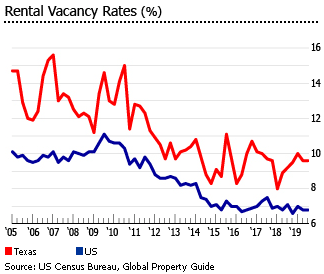
Interest rates remain ultra-low, average mortgage debt rising
The central bank has indicated it intends to hold rates steady in 2020, having loweredthe Fed rate twice last year to 1.5%-1.75%.
Mortgage interest rates are falling again:
- 30-year fixed rate mortgage (FRMs) average rates were 3.7% in November 2019, down from 4.87% in November 2018.
- 15-year FRM average rates were 3.16% in November 2019, down from 4.28% a year earlier.
- 5-year adjustable rate mortgages (ARMs) fell to 3.41% in November 2019 from 4.11% a year earlier.
As a result of falling interest rates and a prosperous economyTexans have been borrowing: the average mortgage debt per borrower in Texas rose by 3.6% y-o-y to US$176,736 this year, according to Experian. But this is around 13% lower than the national-wide average mortgage debt, which stands at US$202,284.
Residential construction rising strongly
In the first ten months of 2019, new privately-owned housing units authorized in Texas rose strongly by 7.3% to 168,006 units from the same period last year, following annual growth of 10.1% in 2018 and 5.6% in 2017, according to the US Census Bureau.
By major areas:
- In Houston-The Woodlands-Sugar Land, housing units authorized surged 12.1% y-o-y to 51,794 units
- In Dallas-Fort Worth-Arlington, housing permits rose slightly by 0.7% y-o-y to 53,204 units
- In Austin-Round Rock-Georgetown, housing permits rose by 9.8% y-o-y to 26,968 units
- In San Antonio-New Braunfels, housing units authorized soared 27.2% y-o-y to 11,213 units
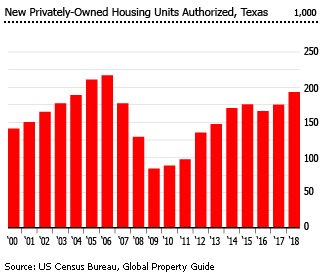
Homeownership rate rising gradually
Homeownership stood at 63% of all homes in Q3 2019, up from the previous year’s 62.7%, according to the US Census Bureau. However, it is actually lower than the national average of 64.8%.
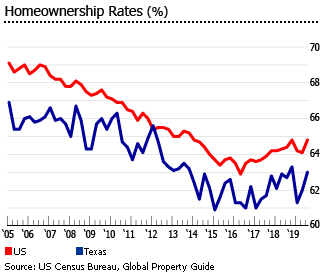
Among the major metro areas in Texas, Beaumont Port Arthur had the highest homeownership rate, at 68%, according to Texas Realtors’ 2018 Real Estate Review. It was followed by McAllen Edinburg Mission (67.5%), Brownsville Harlingen (67.2%), and Midland (67.1%). Homeownership rate was 62.6% in San Antonio New Braunfels, 60.5% in Houston The Woodlands Sugar Land, 59.8% in Dallas Fort Worth Arlington, and 58.3% in Austin Round Rock.
From an average of 65.7% in 2005-2010, the state’s homeownership rate fell to an average of 62.7% in the past 8 years.
Robust economic growth, low unemployment
The Texas economy expanded by an annualized rate of 4.7% in Q2 2019 – the highest growth among the 50 US states, according to the US Bureau of Economic Analysis.
With the ongoing US-China trade war, the state’s performance is impressive. Texas is the top exporting US state, accounting for almost 20% of US exports.
“The Q2 GDP growth number for Texas is indicative of the continued strength and diversity of the Texas economy,” said Texas Comptroller Glenn Hegar. “While some of this growth is attributable to a corresponding uptick in mining sector activity during the second quarter, continued diversification of the Texas economy has made our state less reliant on a single sector to drive economic growth. That is part of the reason for Texas’ greater growth even among energy producing states.”
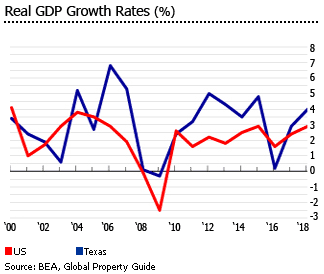
However Texas will suffer severe consequences if the United States-Mexico-Canada Agreement (USMCA) – the replacement of the 25-year old NAFTA –isn´t ratified soon, given the state’s close trade ties with both Mexico and Canada, some legislators warned.
“We believe that no state will gain more from this new agreement than Texas, and no state has more to lose if it doesn’t pass than our state,” said US Representative Kevin Brady.
Trade with Mexico and Canada supports about 1 million jobs in Texas and was worth US$230 billion last year, according to the US Chamber of Commerce.
The state’s economy grew by a robust 4% in 2018, following expansions of 2.9% in 2017, 0.2% in 2016, 4.8% in 2015 and 3.5% in 2014.
Unemployment was at a record low of 3.4%, down from 3.7% a year earlier, according to the US Bureau of Labor Statistics (BLS).
Sources:
- Texas Quarterly Housing ReportQ3 2019 (Texas Realtors): https://www.texasrealestate.com/wp-content/uploads/TQHR_2019_Q3.pdf
- Texas Real Estate Year in Review 2018 (Texas Realtors): https://www.texasrealestate.com/wp-content/uploads/2018TexasRealEstateYearinReview.pdf
- House Price Index Datasets (Federal Housing Finance Agency): https://www.fhfa.gov/DataTools/Downloads/Pages/House-Price-Index-Datasets.aspx#qpo
- Texas International Homebuyers Report 2019 edition (Texas Realtors): https://www.texasrealestate.com/wp-content/uploads/2019TexasInternationalHomebuyerReport.pdf
- GDP by State (US Bureau of Economic Analysis): https://www.bea.gov/data/gdp/gdp-state
- Housing Vacancies and Homeownership (CPS/HVS) (US Census Bureau): https://www.census.gov/housing/hvs/data/rates.html
- Texas Home Prices & Values (Zillow): https://www.zillow.com/tx/home-values/
- Mortgage Loan Debt Increases for the Seventh Straight Quarter (Experian): https://www.experian.com/blogs/ask-experian/how-much-americans-owe-on-their-mortgages-in-every-state/
- Texas Housing Insight (Texas A&M University Real Estate Center): https://assets.recenter.tamu.edu/Documents/Articles/2120.pdf
- Texas’ Economic Growth More Than Double the Nation’s, Data Shows (The Texan): https://thetexan.news/texas-economic-growth-more-than-double-the-nation-data-shows/
- Texas will suffer economic consequences if USMCA isn’t passed, Congress members warn (The Dallas Morning News): https://www.dallasnews.com/news/politics/2019/12/05/
- ATTOM Data Solutions Ranks Best Counties for Buying Single Family Rentals in 2019 (ATTOM Data Solutions): https://www.attomdata.com/news/market-trends/attom-data-solutions-q1-2019-single-family-rental-market-report/